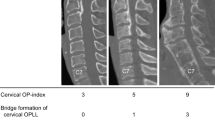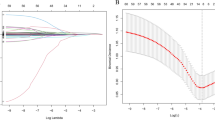Abstract
Study design
Biomechanical study.
Objective
Cervical ossification of the posterior longitudinal ligament (C-OPLL) causes myelopathy. Though posterior decompression for C-OPLL showed positive results, poor outcomes were seen in patients with a kyphotic alignment. Posterior decompression with fusion (PDF) tends to show better results compared to posterior decompression. The aim of this study is to evaluate the effects of the posterior procedures for C-OPLL.
Setting
Yamaguchi University.
Methods
Based on 3D finite element C2-C7 spine created from medical images and a spinal cord, the following compression models were created: the intact model, K-line 0 mm model, and K-line 2 mm model. These models were used to analyze the effects of posterior decompression with varied lengths of fixation. The stress of the spinal cord was calculated for intact, K-line 0 mm, and K-line 2 mm as preoperative models, and laminectomy (LN)-K-line 0 mm, PDF (C4-C5)-K-line 0 mm, PDF (C3-C6)-K-line 0 mm, LN-K-line 2 mm, PDF (C4-C5)-K-line 2 mm, and PDF (C3-C6)-K-line 2 mm model as operative models in a neutral, flexion, and extension.
Results
As the compression increased, stress on the spinal cord increased compared to the intact model. In the neutral, posterior decompression decreased the stress of the spinal cord. However, in flexion and extension, the stress on the spinal cord for LN-K-line 0 or 2 mm, PDF (C4-C5)-K-line 0 or 2 mm, and PDF (C3-C6)-K-line 0 or 2 mm models decreased by more than 40%, 43%, and 70% respectively compared to the K-line 0 or 2 mm model.
Conclusions
In kyphotic C-OPLL, it is essential to control intervertebral mobility in the posterior approach.
Similar content being viewed by others
Log in or create a free account to read this content
Gain free access to this article, as well as selected content from this journal and more on nature.com
or
Data availability
The data presented in this study are available.
References
Kawaguchi Y, Imagama S, Iwasaki M, Kaito T, Koda M, Chikuda H, et al. Japanese Orthopaedic Association (JOA) clinical practice guidelines on the management of ossification of the spinal ligament, 2019. J Orthop Sci. 2021;26:1–45.
Sakai K, Yoshii T, Hirai T, Arai Y, Torigoe I, Tomori M, et al. Cervical Sagittal Imbalance is a Predictor of Kyphotic Deformity After Laminoplasty in Cervical Spondylotic Myelopathy Patients Without Preoperative Kyphotic Alignment. Spine (Philos Pa 1976). 2016;41:299–305.
Iwasaki M, Kawaguchi Y, Kimura T, Yonenobu K. Long-term results of expansive laminoplasty for ossification of the posterior longitudinal ligament of the cervical spine: more than 10 years follow up. J Neurosurg. 2002;96:180–9.
Fujiyoshi T, Yamazaki M, Kawabe J, Endo T, Furuya T, Koda M, et al. A new concept for making decisions regarding the surgical approach for cervical ossification of the posterior longitudinal ligament: the K-line. Spine (Philos Pa 1976). 2008;33:E990–93.
Sakai K, Okawa A, Takahashi M, Arai Y, Kawabata S, Enomoto M, et al. Five-year follow-up evaluation of surgical treatment for cervical myelopathy caused by ossification of the posterior longitudinal ligament: a prospective comparative study of anterior decompression and fusion with floating method versus laminoplasty. Spine (Philos Pa 1976). 2012;37:367–76.
Mayer M, Meier O, Auffarth A, Koller H. Cervical laminectomy and instrumented lateral mass fusion: techniques, pearls and pitfalls. Eur Spine J 2015;24:168–85.
Yoshii T, Egawa S, Chikuda H, Wakao N, Furuya T, Kanchiku T, et al. Comparison of anterior decompression with fusion and posterior decompression with fusion for cervical spondylotic myelopathy-A systematic review and meta-analysis. J Orthop Sci. 2020;25:938–45.
Yoshii T, Egawa S, Hirai T, Kaito T, Mori K, Koda M, et al. A systematic review and meta-analysis comparing anterior decompression with fusion and posterior laminoplasty for cervical ossification of the posterior longitudinal ligament. J Orthop Sci. 2020;25:58–65.
Yuan W, Zhu Y, Liu X, Zhu H, Zhou X, Zhou R, et al. Postoperative three-dimensional cervical range of motion and neurological outcomes in patients with cervical ossification of the posterior longitudinal ligament: Cervical laminoplasty versus laminectomy with fusion. Clin Neurol Neurosurg. 2015;134:17–23.
Koda M, Mochizuki M, Konishi H, Aiba A, Kadota R, Inada T, et al. Comparison of clinical outcomes between laminoplasty, posterior decompression with instrumented fusion, and anterior decompression with fusion for K-line (-) cervical ossification of the posterior longitudinal ligament. Eur Spine J. 2016;25:2294–301.
Scheer JK, Tang JA, Smith JS, Acosta FL Jr., Protopsaltis TS, Blondel B, et al. Cervical spine alignment, sagittal deformity, and clinical implications: a review. J Neurosurg Spine. 2013;19:141–59.
Hayashi T, Daubs MD, Suzuki A, Phan K, Shiba K, Wang JC, et al. Effect of Modic changes on spinal canal stenosis and segmental motion in cervical spine. Eur Spine J. 2014;23:1737–42.
Kameyama T, Hashizume Y, Sobue G. Morphologic features of the normal human cadaveric spinal cord. Spine (Philos Pa 1976). 1996;21:1285–90.
Galbusera F, Bellini CM, Anasetti F, Ciavarro C, Lovi A, Brayda-Bruno M, et al. Rigid and flexible spinal stabilization devices: a biomechanical comparison. Med Eng Phys. 2011;33:490–6.
Lu YM, Hutton WC, Gharpuray VM. Can variations in intervertebral disc height affect the mechanical function of the disc? Spine (Philos Pa 1976). 1996;21:2208–16. discussion 17
Cowin SC, Turner CH. On the relationship between the orthotropic Young’s moduli and fabric. J Biomech. 1992;25:1493–4.
Périé D, Hobatho MC, Baunin C, Sales De Gauzy J. Personalised mechanical properties of scoliotic vertebrae determined in vivo using tomodensitometry. Comput Methods Biomech Biomed Engin. 2002;5:161–5.
Ottardi C, Galbusera F, Luca A, Prosdocimo L, Sasso M, Brayda-Bruno M, et al. Finite element analysis of the lumbar destabilization following pedicle subtraction osteotomy. Med Eng Phys. 2016;38:506–9.
Natarajan RN, Watanabe K, Hasegawa K. Biomechanical Analysis of a Long-Segment Fusion in a Lumbar Spine-A Finite Element Model Study. J Biomech Eng. 2018;140:091011.
Ichihara K, Taguchi T, Sakuramoto I, Kawano S, Kawai S. Mechanism of the spinal cord injury and the cervical spondylotic myelopathy: new approach based on the mechanical features of the spinal cord white and gray matter. J Neurosurg. 2003;99:278–85.
Nishida N, Mumtaz M, Tripathi S, Kelkar A, Sakai T, Goel VK, et al. Biomechanical Analysis of Posterior Ligaments of Cervical Spine and Laminoplasty. Appl Sci. 2021;11:7645.
Fujimori T, Iwasaki M, Okuda S, Takenaka S, Kashii M, Kaito T, et al. Long-term results of cervical myelopathy due to ossification of the posterior longitudinal ligament with an occupying ratio of 60% or more. Spine (Philos Pa 1976). 2014;39:58–67.
Chen Y, Guo Y, Lu X, Chen D, Song D, Shi J, et al. Surgical strategy for multilevel severe ossification of posterior longitudinal ligament in the cervical spine. J Spinal Disord Tech. 2011;24:24–30.
Chavanne A, Pettigrew DB, Holtz JR, Dollin N, Kuntz CT. Spinal cord intramedullary pressure in cervical kyphotic deformity: a cadaveric study. Spine (Philos Pa 1976). 2011;36:1619–26.
Winestone JS, Farley CW, Curt BA, Chavanne A, Dollin N, Pettigrew DB, et al. Laminectomy, durotomy, and piotomy effects on spinal cord intramedullary pressure in severe cervical and thoracic kyphotic deformity: a cadaveric study. J Neurosurg Spine. 2012;16:195–200.
Harrison DE, Cailliet R, Harrison DD, Troyanovich SJ, Harrison SO. A review of biomechanics of the central nervous system-Part III: spinal cord stresses from postural loads and their neurologic effects. J Manipulative Physiol Ther. 1999;22:399–410.
Jarzem PF, Quance DR, Doyle DJ, Begin LR, Kostuik JP. Spinal cord tissue pressure during spinal cord distraction in dogs. Spine (Philos Pa 1976). 1992;17:S227–234.
Jarzem PF, Kostuik JP, Filiaggi M, Doyle DJ, Ethier R, Tator CH, et al. Spinal cord distraction: an in vitro study of length, tension, and tissue pressure. J Spinal Disord. 1991;4:177–82.
Henderson FC, Geddes JF, Vaccaro AR, Woodard E, Berry KJ, Benzel EC, et al. Stretch-associated injury in cervical spondylotic myelopathy: new concept and review. Neurosurgery. 2005;56:1101–13. discussion -13
Kim YH, Khuyagbaatar B, Kim K. Biomechanical effects of spinal cord compression due to ossification of posterior longitudinal ligament and ligamentum flavum: a finite element analysis. Med Eng Phys. 2013;35:1266–71.
Kato Y, Kanchiku T, Imajo Y, Kimura K, Ichihara K, Kawano S, et al. Biomechanical study of the effect of degree of static compression of the spinal cord in ossification of the posterior longitudinal ligament. J Neurosurg Spine. 2010;12:301–5.
Nishida N, Kanchiku T, Imajo Y, Suzuki H, Yoshida Y, Kato Y, et al. Stress analysis of the cervical spinal cord: Impact of the morphology of spinal cord segments on stress. J spinal cord Med. 2016;39:327–34.
Nishida N, Kanchiku T, Kato Y, Imajo Y, Suzuki H, Yoshida Y, et al. Cervical ossification of the posterior longitudinal ligament: factors affecting the effect of posterior decompression. J spinal cord Med. 2017;40:93–99.
Tsuyama N. Ossification of the posterior longitudinal ligament of the spine. Clin Orthop Relat Res. 1984;184:71–84.
Maruo K, Moriyama T, Tachibana T, Inoue S, Arizumi F, Daimon T, et al. The impact of dynamic factors on surgical outcomes after double-door laminoplasty for ossification of the posterior longitudinal ligament of the cervical spine. J Neurosurg Spine. 2014;21:938–43.
Acknowledgements
The authors express their thanks to the members of the Medical and Mechanical Engineering Laboratory of the same college and the graduate students at this laboratory for their co-operation.
Funding
This work was supported by JSPS KAKENHI grant JP 15K20002.
Author information
Authors and Affiliations
Contributions
Conceptualization: N.N. Data curation and Formal analysis: T.A., R.T. and F.J. Funding acquisition: N.N. Methodology: N.N., Y.I., H.S, and M.F. Project administration: N.N. and C.X. Supervision: T.S. Validation: T.A., R.T. and N.N Visualization: T.S. Writing—original draft: N.N. Writing—review & editing, Y.K., and J.O. All authors have read and agreed to the published version of the manuscript.
Corresponding author
Ethics declarations
Competing interests
The authors declare no competing interests.
Ethics approval
The present study was approved by the Ethics Committee at the Center for Clinical Research, Yamaguchi University Hospital (Ube, Japan; approval no. H28-054). Written informed consent for this study and its publication was obtained from all subjects.
Additional information
Publisher’s note Springer Nature remains neutral with regard to jurisdictional claims in published maps and institutional affiliations.
Rights and permissions
Springer Nature or its licensor holds exclusive rights to this article under a publishing agreement with the author(s) or other rightsholder(s); author self-archiving of the accepted manuscript version of this article is solely governed by the terms of such publishing agreement and applicable law.
About this article
Cite this article
Nishida, N., Jiang, F., Asano, T. et al. Effect of posterior decompression with and without fixation on a kyphotic cervical spine with ossification of the posterior longitudinal ligament. Spinal Cord 61, 133–138 (2023). https://doi.org/10.1038/s41393-022-00857-z
Received:
Revised:
Accepted:
Published:
Issue date:
DOI: https://doi.org/10.1038/s41393-022-00857-z
This article is cited by
-
Surgical options for ossification of the posterior longitudinal ligament of the cervical spine: a narrative review
Journal of Orthopaedic Surgery and Research (2024)



